FRIDAY, SEPTEMBER 16
■ The late-rising Moon shines in line with Mars and Aldebaran to its right, as shown below. The Moon is less than a day from being last quarter.
The Moon is about 4° or 5° from Mars as seen from the longitudes of the Americas. That's a good two or three finger-widths at arm's length, but this is still the closest pairing of the Moon and a bright planet visible this month from North America.
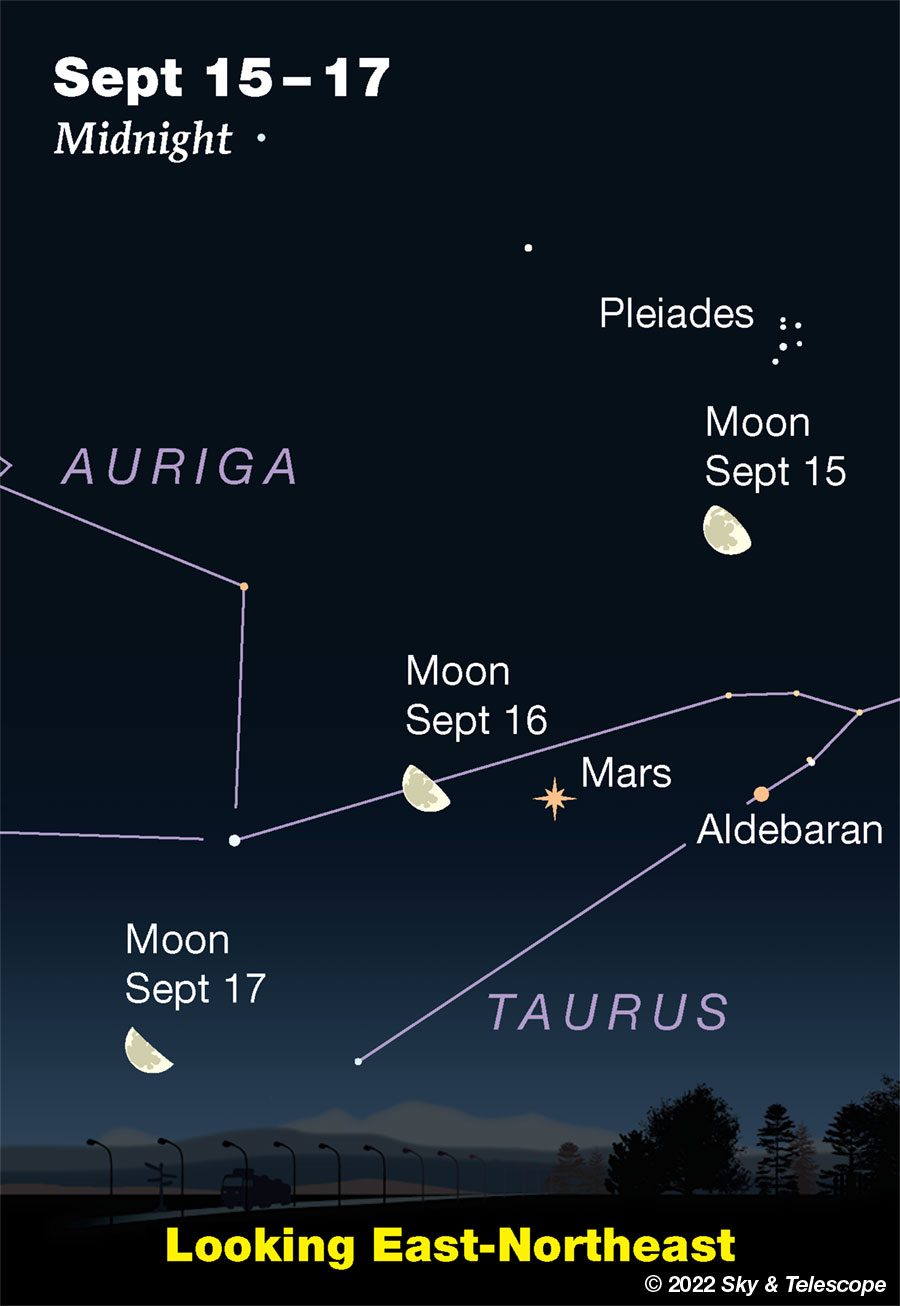
SATURDAY, SEPTEMBER 17
■ Neptune is at opposition. It's magnitude 7.8 in eastern Aquarius. Equally bright (or faint) this week is the asteroid 3 Juno about 10° to Neptune's west. Using a telescope or large binoculars, find them both in late evening using the article and charts in the September Sky & Telescope, page 49.
And some 20° west-southwest of Juno, brighter 4 Vesta shines on at about magnitude 6.4. Use the finder chart in the August Sky & Telescope, page 49.
■ Last-quarter Moon (exact at 5:52 p.m. EDT). The Moon rises around 11 or midnight in the northeast, two fists lower right of Capella.
Once the Moon is well up, you can see that it makes a nearly equilateral triangle, 7° on a side, with the two horn-tip stars of Taurus: Beta and Zeta Tauri. They're to its upper right and right, respectively, as shown above.
SUNDAY, SEPTEMBER 18
■ Arcturus shines in the west these evenings after twilight fades out. About a half hour after nightfall is complete, brighter Jupiter shines at the same height in the east. How well can you time their exact balance?
When that happens, barely rising in the north-northeast is Capella (depending on your latitude; the farther north you are the higher Capella will be.)
Later in the evening, it's the turn of Arcturus and Capella to shine at the same height. Both are magnitude 0. Again, the time of this will depend on your latitude and longitude.
When it happens, turn and look low in the south-southeast. There will be 1st-magnitude Fomalhaut at about the same height too — exactly so if you're at latitude 43° north (Boston, Buffalo, Milwaukee, Boise, Eugene). Seen from south of that latitude, Fomalhaut will appear higher than Capella and Arcturus are. Seen from north of there, it will be lower.
MONDAY, SEPTEMBER 19
■ This is the time of year when the rich Cygnus Milky Way crosses the zenith in the hour after nightfall is complete (for skywatchers at mid-northern latitudes). The Milky Way extends straight up from the southwest horizon between Sagittarius and the tail of Scorpius, passes overhead, and runs straight down to the northeast through Cassiopeia and Perseus.
TUESDAY, SEPTEMBER 20
■ House-shaped Cepheus, in the edge of the Milky Way, is high in the northeast these evenings, as shown on the center star chart of the September Sky & Telescope. It's home to the prototype Cepheid variable star, Delta Cephei.
Delta Cep remains naked-eye throughout its cycle; it pulses from magnitude 4.4 to 3.5 and back every 5 days 9 hours. Make a point of looking up from time to time and comparing Delta with nearby Epsilon and Zeta Cephei, mags 4.2 and 3.3 respectively. Those two comparisons nearly frame Delta's brightness range. Use the chart for this trio in Matt Wedel's Binocular Highlight column with the September center chart.
In a telescope Delta Cep is also a lovely double star. Its companion, magnitude 6.3, is 41 arcseconds away.
WEDNESDAY, SEPTEMBER 21
■ Spot the Big Dipper scooping low in the northwest. Examine Mizar, the middle star of its bent handle. Can you see its tiny close companion Alcor? Since this is the time of year when Vega is crossing the zenith in early evening, it's also when Alcor stands straight over Mizar. Because a line from Mizar through Alcor always points to Vega.
■ In early dawn tomorrow the 22nd, the waning crescent Moon hangs above Regulus in the east as shown below. The Moon forms the tip of a nearly isosceles triangle with Regulus and yellow-orange Gamma Leonis.
On Friday morning the 23rd, Regulus will be left of the Moon — forming a smaller, flatter isosceles triangle with those two stars.
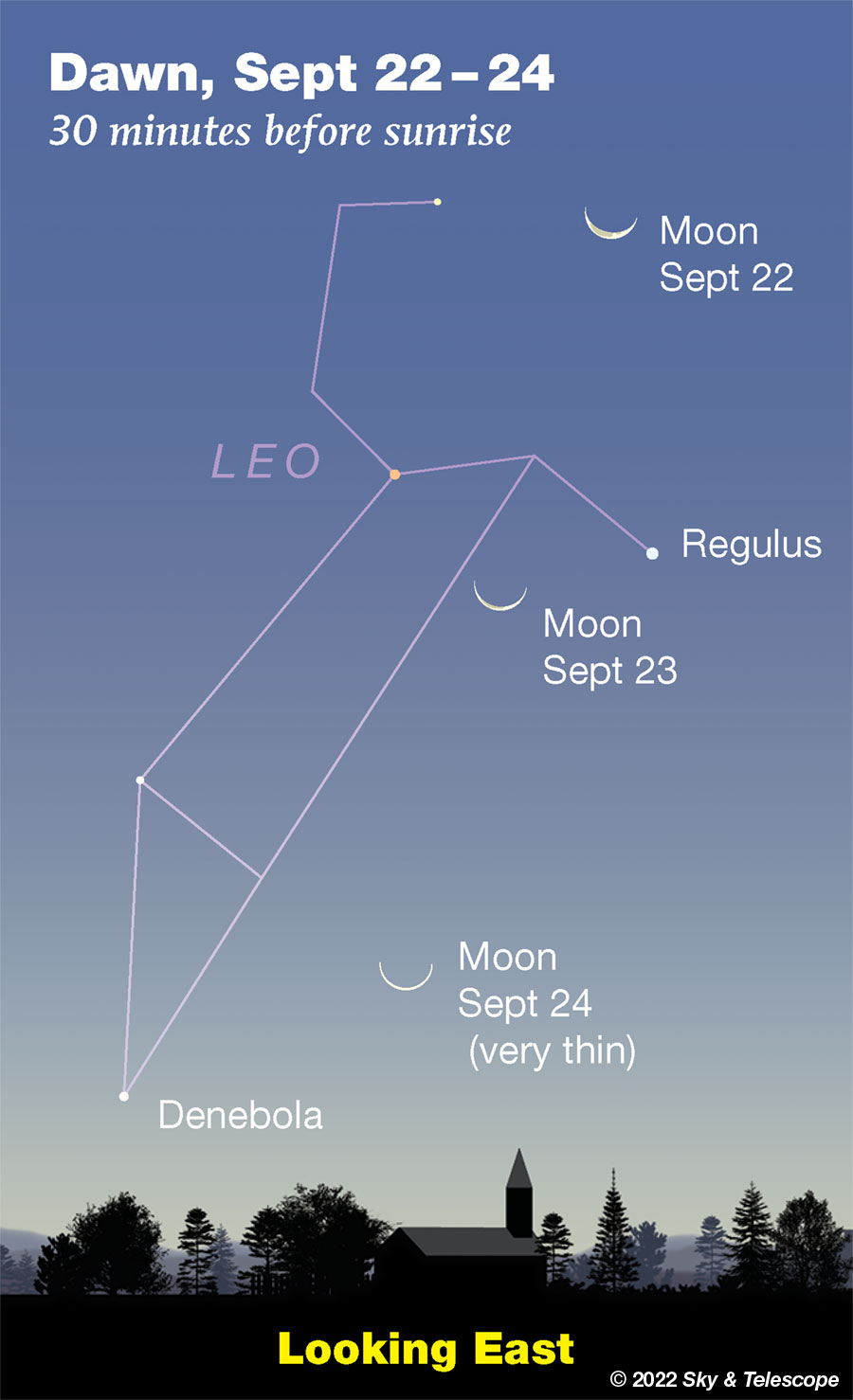
THURSDAY, SEPTEMBER 22
■ Earth passes through the September equinox at 9:04 p.m. EDT. This is when fall begins in the Northern Hemisphere, astronomically speaking: when the center of the Sun crosses Earth's equator and, equivalently, the celestial equator. The Sun is migrating south.
■ As summer turns to fall, you'll always find the Sagittarius Teapot moving west of south during evening. It's tipping increasingly far over to the right, as if pouring out the last of summer.
■ Meanwhile the Great Square of Pegasus, emblem of fall, is getting high in the east. Look for it above bright Jupiter and maybe a bit left. It's balancing on one corner, as it always does when we see it in either the east or the west. Only when the Great Square is very high and more or less south does it sit level like a box.
FRIDAY, SEPTEMBER 23
■ And, also to mark the summer-to-fall transition every year, Deneb takes over from brighter Vega as the major star nearest the zenith after nightfall (for skywatchers at mid-northern latitudes).
SATURDAY, SEPTEMBER 24
■ Arcturus shines ever lower in the west-northwest after dark. The narrow kite shape of its constellation, Bootes, extends two fists at arm's length to Arcturus's upper right; Arcturus is where the kite's downward-hanging tail is tied on.
To the right of Bootes, the Big Dipper is turning more level.
And this is the time of year when, during the evening, the dim Little Dipper "dumps water" into the bowl of the Big Dipper way down below. The Big Dipper will dump it back in the evenings of spring.
This Week's Planet Roundup
Mercury is hidden in conjunction with the Sun.
Venus, magnitude –3.9, rises in mid-dawn about 40 minutes before sunrise. As dawn brightens, look for it very low almost due east. How near to sunrise can you hold it in view?
Mars, magnitude –0.4 in Taurus, clears the east-northeast horizon by around 11 p.m. It gains altitude for the rest of the night.
Mars is four times as bright as Mars-colored Aldebaran, magnitude +0.9, sparkling to its right or lower right. Look for the Pleiades above Aldebaran.
Mars is now 11 arcseconds in diameter and growing. The best time to observe it telescopically is before dawn, when it's highest. Mars will be 17.2 arcseconds across when closest to Earth on December 1st.
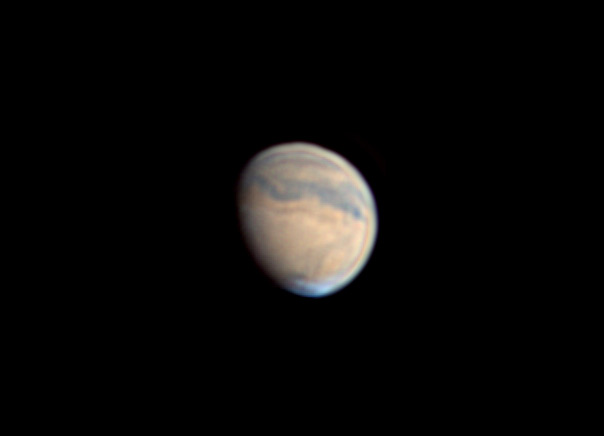
Jupiter comes to opposition next week. At a bright magnitude –2.9, you can spot it very low due east as twilight fades. It dominates the east after dark, then the higher southeast, shining in otherwise bland Pisces. Jupiter stands highest in the south around 1 a.m. daylight-saving time.
In a telescope Jupiter is a remarkable 50 arcseconds wide across its equator, its maximum possible; Jupiter this season is very close to the perihelion of its 12-year orbit around the Sun.
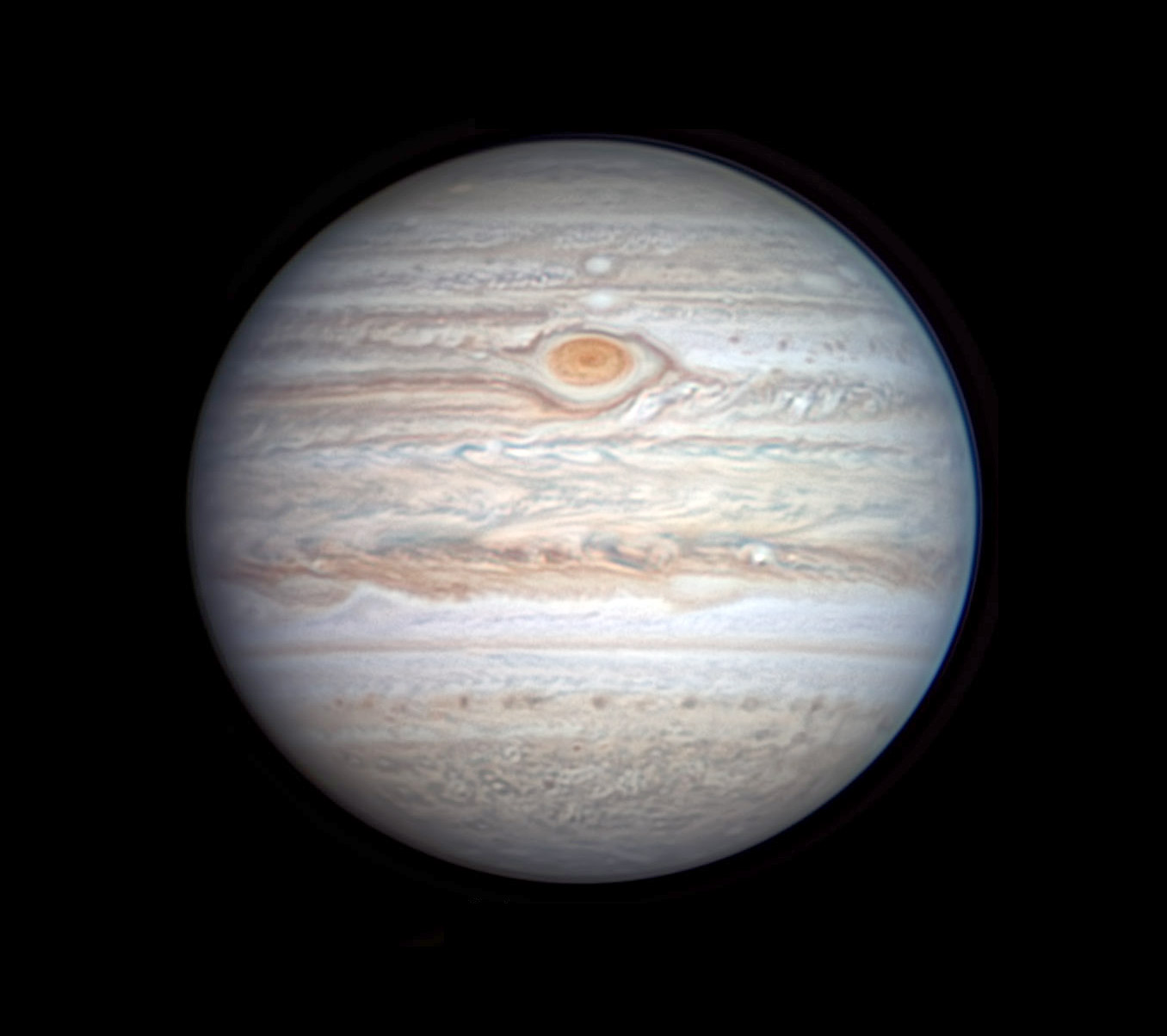
Saturn, magnitude +0.4 in Capricornus, is already well up in the southeast as twilight fades. Spot it 45° west (upper right) of Jupiter. That's four or five fist-widths at arm's length. Saturn is at its highest in the south around 10 p.m.
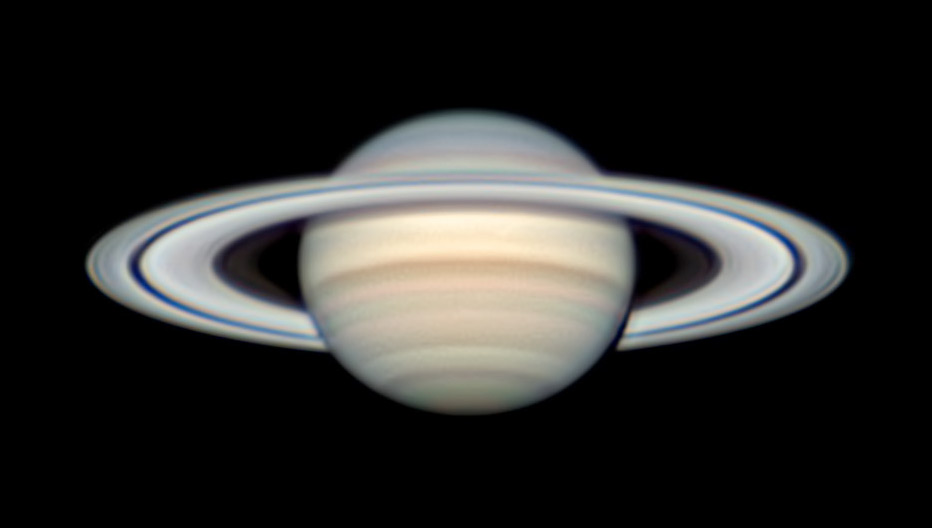
The gray band seen on the globe along the inner edge of the rings is not a belt or a shadow but the semi-transparent C ring.
Uranus, magnitude 5.7 in Aries, is well west of Mars. It's up in good binocular or telescopic view by late evening. See the Uranus finder charts in the November Sky & Telescope, page 49.
Neptune, magnitude 7.8 at the Aquarius-Pisces border, is west of Jupiter. See the Neptune finder charts in the September Sky & Telescope, page 49. And use the charts there too for the asteroid 3 Juno nearby, about the same magnitude.
All descriptions that relate to your horizon — including the words up, down, right, and left — are written for the world's mid-northern latitudes. Descriptions and graphics that also depend on longitude (mainly Moon positions) are for North America.
Eastern Daylight Time, EDT, is Universal Time minus 4 hours. (Universal Time is also called UT, UTC, GMT or Z time.)
Want to become a better astronomer? Learn your way around the constellations. They're the key to locating everything fainter and deeper to hunt with binoculars or a telescope.
This is an outdoor nature hobby. For an easy-to-use constellation guide covering the whole evening sky, use the big monthly map in the center of each issue of Sky & Telescope, the essential magazine of astronomy.
Once you get a telescope, to put it to good use you'll need a detailed, large-scale sky atlas (set of charts). The basic standard is the Pocket Sky Atlas (in either the original or Jumbo Edition), which shows stars to magnitude 7.6.

Next up is the larger and deeper Sky Atlas 2000.0, plotting stars to magnitude 8.5; nearly three times as many. The next up, once you know your way around, are the even larger Interstellarum atlas (stars to magnitude 9.5) or Uranometria 2000.0 (stars to magnitude 9.75). And be sure to read How to Use a Star Chart with a Telescope. It applies just as much to charts on your phone or tablet as to charts on paper.
You'll also want a good deep-sky guidebook. A beloved old classic is the three-volume Burnham's Celestial Handbook. An impressive more modern one is the big Night Sky Observer's Guide set (2+ volumes) by Kepple and Sanner.
Can a computerized telescope replace charts? Not for beginners, I don't think, and not on mounts and tripods that are less than top-quality mechanically, meaning heavy and expensive. And as Terence Dickinson and Alan Dyer say in their Backyard Astronomer's Guide, "A full appreciation of the universe cannot come without developing the skills to find things in the sky and understanding how the sky works. This knowledge comes only by spending time under the stars with star maps in hand."
![]() Audio sky tour. Out under the evening sky with your
Audio sky tour. Out under the evening sky with your
earbuds in place, listen to Kelly Beatty's monthly
podcast tour of the heavens above. It's free.
"The dangers of not thinking clearly are much greater now than ever before. It's not that there's something new in our way of thinking, it's that credulous and confused thinking can be much more lethal in ways it was never before."
— Carl Sagan, 1996
"Facts are stubborn things."
— John Adams, 1770
 7
7









Comments
misha17
September 16, 2022 at 1:22 pm
I noticed the Moon was about halfway between Jupiter and Mars on Wednesday night and realized:
- Saturn was at opposition in late August
- Jupiter will be at opposition next week in late September
- Mars is currently near Aldebaran, which is opposite the Sun in late November
... so Saturn, Jupiter, the Moon, and Mars were roughly 30 degrees apart from each other in the sky, and showed how far Sun moves in a month as it goes 180 degrees from each of them one month at a time (since Jupiter and Saturn move so slowly, and could be treated as "stars" for positioning purposes)
You must be logged in to post a comment.
Rod
September 19, 2022 at 6:13 am
Lovely early morning sky at my location today near 0600 EDT. The waning crescent Moon in Gemini along with Mars in Taurus, Orion up high. I was tempted to take out my 90-mm refractor telescope and do some observing but the coffee was calling 🙂 Looks like Friday night for me will be a very good time for stargazing and Jupiter observing so I am planning an observation run.
You must be logged in to post a comment.
Rod
September 20, 2022 at 8:10 am
For those with small telescopes, this Jupiter opposition on 26-Sep, we should be able to see some of the Galilean moons as small, round moons, not just a point of light. I did this in June 2019.
https://forums.space.com/threads/nasa-says-jupiter-is-at-its-closest-in-59-years.57759/
I anticipate doing this again this month using my 90-mm refractor and 10-inch Newtonian telescopes.
You must be logged in to post a comment.
Rod
September 21, 2022 at 6:40 am
I did get out my telescope last night and viewed a Ganymede transit at Jupiter.
Observed 2130-2345 EDT 20-Sep-2022/0130 UT-0345 UT 21-Sep-2022. Ganymede transit and shadow transit observed this evening using Orion Sirius 25-mm plossl at 40x, TeleVue 9-mm Nagler at 111x, and 9-mm with TeleVue 1.8x Barlow lens for 200x using 90-mm refractor. I used #58 Green and #12 Yellow filters. Ganymede black shadow difficult to see at 40x. 111x and 200x views no problem, especially using #58 Green filter. Numerous cloud bands visible, shading in north polar region and in south polar region. Near 2315 EDT or 0315 UT, I could see Ganymede and its shadow approaching Jupiter's limb. The shadow ~ 2 arcsecond or larger angular size and Ganymede ~ 1.7/1.8 arcsecond size. At 200x, Ganymede approaching the limb of Jupiter at egress looked like a small round moon. While I did not see all the Ganymede transit and shadow transit this evening, I did enjoy observing a great deal of the show. According to Sky & Telescope tool for Jupiter moons, Ganymede shadow transit began 0010 UT, Ganymede transit began 0058 UT and the entire show ended 0328 UT when Ganymede moved away from Jupiter’s disk (egress). Before I finished observing, I enjoyed some 40x observations of M45 (Pleiades) rising in Taurus with true FOV ~ 1.3-degrees. An enjoyable evening watching Ganymede move across Jupiter and its black shadow. Ganymede appeared as a small moon near the limb of Jupiter, not just a point of light. During the transit there were times I could see Ganymede against the disk of Jupiter along with its black shadow, especially as Ganymede approached closer to egress and Jupiter’s limb. My 10-inch Newtonian does a great job here, the images are brighter with more detail. However, the 90-mm refractor telescope easier to setup and bring in when done. Skies clear with temperature 17C.
You must be logged in to post a comment.
mary beth
September 21, 2022 at 11:35 am
Happy Autumn Eve to all! Hope everyone has having some clear sky to enjoy the beauty of the changing seasons. During the daytime the slanted son is so beautiful
You must be logged in to post a comment.
mary beth
September 21, 2022 at 11:42 am
Oh geez I meant to correct my misspelling and I accidentally hit submit. Anyway the angle of the sun is gorgeous during the day and at night we have Antares and Arcturus twinkling beautifully and colorfully in their lower positions. So wonderful to see Jupiter! I also am getting lots of nice glimpses of Fomalhaut, the lonely autumn star, as long as I stay outside past 10. Love the little tradition of Sky and Telescope that says the teapot of Sagittarius is “pouring out the last drops of summer”. Hope everyone can still see it.
Rod, your reports were wonderful. Your weather sounds lovely. Nice you could see Ganymede as a moon, not just a light. How many stars/sisters did you see in the Pleiades?
You must be logged in to post a comment.
Rod
September 21, 2022 at 1:59 pm
mary beth, using my telescope I could see many stars in M45 🙂 Usually I can see 6 or 7 naked eye. Bob King has a good report on Jupiter and opposition this month, https://skyandtelescope.org/astronomy-news/jupiters-exceptionally-close-opposition/
Bob and I both were out last night viewing Jupiter and Ganymede transit and shadow transit but from very different locations 🙂 I think Bob King uses a 15-inch Newtonian telescope, I used my 90-mm refractor, the view was very good.
You must be logged in to post a comment.
You must be logged in to post a comment.